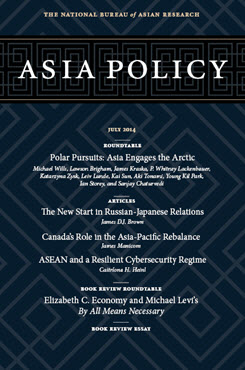Beyond the Dragon and the Panda
Understanding China's Engagement in the Arctic
This essay is part of the roundtable “Polar Pursuits: Asia Engages the Arctic.”
China was granted observer status to the Arctic Council in May 2013, alongside four other Asian countries and Italy. This news was well received by the Chinese media. The People’s Daily, for example, China’s highest-ranking official media outlet, stated that “China will continue to cooperate with the Arctic Council and Arctic countries as before, and contribute to the response to climate change and the protection of the Arctic’s environment.” [1] China was first invited to attend Arctic Council meetings as an ad hoc observer in 2006, and applied for full observer status the following year. The acceptance of China as an observer was the result of its long engagement in Arctic affairs. The Arctic countries recognized these past contributions and expect China to make future contributions as a legitimate Arctic stakeholder with an interest in addressing the challenges facing the region. After a brief overview of the history of China’s activities in the Arctic, the essay will discuss why China is interested in the Arctic and then examine the challenges and opportunities facing the country’s future engagement in this region.
China’s History of Engagement in the Arctic
China has a long history of engagement in Arctic affairs, dating back to the 1920s when it was a signatory of the Svalbard Treaty. However, after the founding of the People’s Republic of China (PRC) in 1949, China’s polar expeditions mainly focused on Antarctica, with Arctic research lagging far behind.
China did not begin paying more attention to the Arctic until the 1990s, when research into climate change and its possible impacts on China gained momentum and elevated this issue higher on the country’s agenda. China’s engagement in Arctic affairs is mainly evidenced by its scientific research expeditions to the Arctic. The first expedition was carried out in 1999, four subsequent expeditions were undertaken in 2003, 2008, 2010, and 2012, and the sixth one will be carried out from July to September 2014. The main objectives of these expeditions evolved from single-issue scientific research on climate change and the melting of sea ice to include the more comprehensive goals of providing an integrated environmental assessment and exploring the possibilities of opening the Arctic passages, along with the social, economic and political implications of these changes in the Arctic.
In the social science field, until a decade ago there was barely any research on the Arctic published in Chinese academic journals. In the past ten years, however, Chinese researchers have published papers on topics including Arctic governance, the Arctic strategies of Arctic states, Arctic environmental change and the implications for China, and, most saliently, the legal and political regimes governing Arctic passages as well as strategies for China’s further engagement in Arctic affairs. The rise in social science scholarship on the region is natural because the economic implications of the Arctic passages are a top concern for the Chinese leadership, which would like to become more active in regional affairs. The government’s interest in the region is also reflected in the projects funded by the National Social Sciences Fund of China, which is regarded as the highest-level official research-funding agency for social sciences in the country. Those research projects that were funded include projects studying the present system and future development of legal and political regimes governing the Arctic passages and their implications for China, approaches for China’s further engagement in the region, and the role of indigenous peoples in Arctic affairs.
Drivers of Chinese Interest in the Arctic
As suggested by the preceding discussion, multiple concerns drive China’s engagement with the Arctic. First, China is motivated by the economic prospects of the opening of Arctic passages, especially the Northern Sea Route (NSR). Optimistic commentators in China view shorter distances and freedom from piracy as the most attractive reasons for the country to pursue northern alternatives to the southern sea routes through the Malacca Strait. Second, as one of the world’s fastest-growing countries, China must secure sufficient supplies of energy and natural resources to sustain its growth. The resource-rich Arctic offers new possibilities in China’s global search for energy, and strategic engagement in the region…
Endnotes
[1] Zhonghua Liu and Lu Shang, “Zhongguo chengwei Beiji Lishihui zhengshi guanchayuan” [China Becomes Formal Observer Country to the Arctic Council], People’s Daily, May 16, 2013.
About Asia Policy
Asia Policy is a peer-reviewed scholarly journal presenting policy-relevant academic research on the Asia-Pacific that draws clear and concise conclusions useful to today’s policymakers. Asia Policy is published quarterly in January, April, July, and October and accepts submissions on a rolling basis. Learn more


